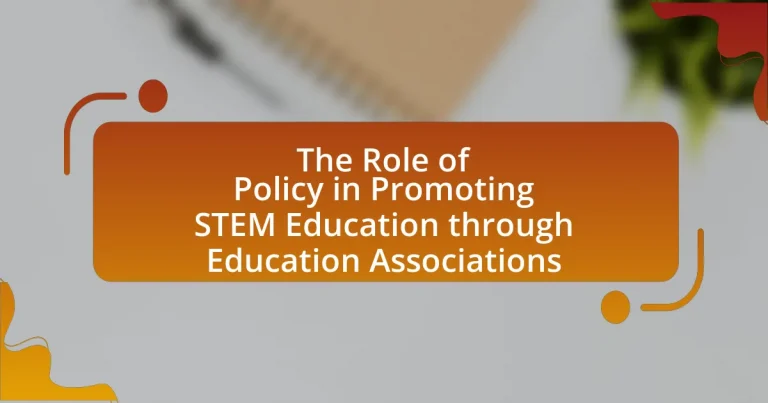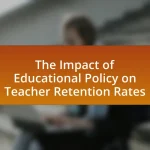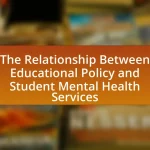The article examines the critical role of policy in promoting STEM education through education associations. It highlights how policies, such as the Every Student Succeeds Act (ESSA), influence funding, curriculum standards, and accountability measures, ultimately shaping STEM initiatives. Key education associations, including the National Science Teachers Association and the American Association for the Advancement of Science, are discussed for their advocacy and implementation of effective STEM programs. The article also addresses the importance of STEM education in today’s job market, the skills it develops in students, and the economic impact of a well-trained STEM workforce. Additionally, it explores challenges faced by education associations, potential improvements in policy, and future trends in STEM education.
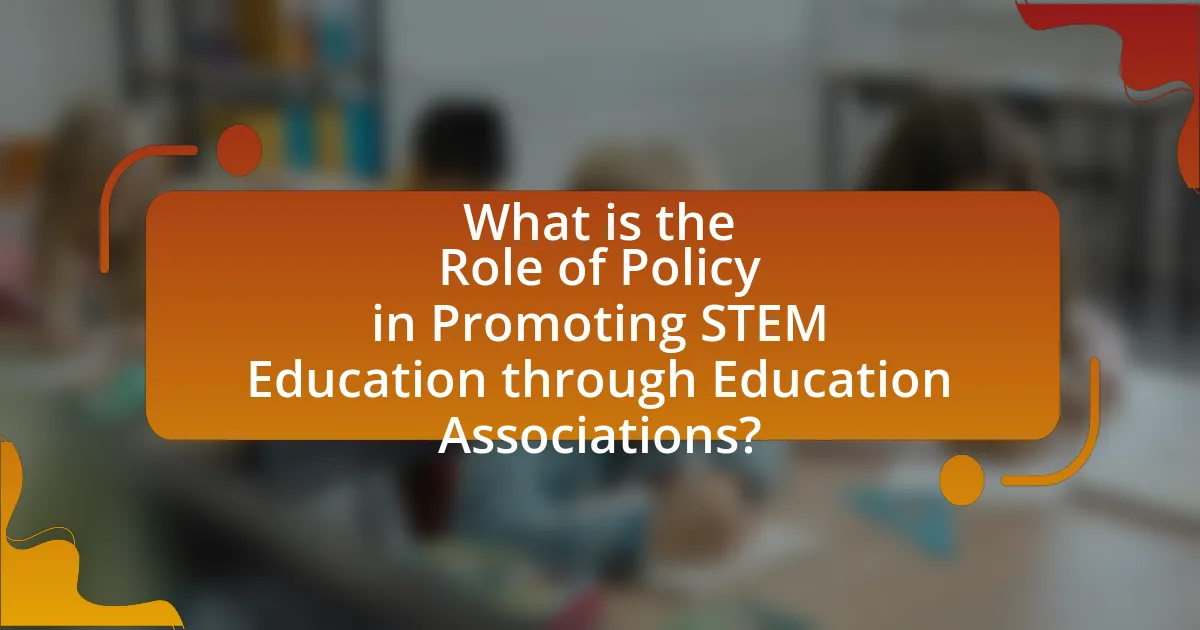
What is the Role of Policy in Promoting STEM Education through Education Associations?
Policy plays a crucial role in promoting STEM education through education associations by establishing frameworks that guide curriculum development, resource allocation, and professional development. These policies often prioritize STEM initiatives, ensuring that education associations can effectively implement programs that enhance STEM learning opportunities. For instance, the Every Student Succeeds Act (ESSA) in the United States encourages states to develop comprehensive STEM education plans, which education associations can leverage to align their efforts with national standards and funding opportunities. This alignment not only fosters collaboration among educators but also enhances the quality and accessibility of STEM education across diverse student populations.
How do policies influence STEM education initiatives?
Policies significantly influence STEM education initiatives by establishing funding priorities, curriculum standards, and accountability measures. For instance, federal policies like the Every Student Succeeds Act (ESSA) allocate resources specifically for STEM programs, encouraging states to integrate STEM education into their curricula. Additionally, policies can mandate the inclusion of STEM subjects in educational standards, which shapes how schools approach teaching these disciplines. Research from the National Science Foundation indicates that states with strong STEM policies see higher student engagement and achievement in science and mathematics, demonstrating the direct impact of policy on educational outcomes in STEM fields.
What types of policies are most effective in promoting STEM education?
Policies that are most effective in promoting STEM education include funding for STEM programs, curriculum development initiatives, and partnerships between educational institutions and industry. Funding policies, such as the National Science Foundation’s grants, provide essential resources for schools to enhance STEM facilities and training. Curriculum development initiatives, like the Next Generation Science Standards, ensure that educational content is relevant and engaging, fostering student interest in STEM fields. Additionally, partnerships with industry, exemplified by programs like Project Lead The Way, create real-world connections that enhance learning and provide students with practical experience. These policies collectively contribute to a robust STEM education framework, evidenced by increased student enrollment in STEM courses and improved performance in standardized assessments.
How do education associations implement these policies?
Education associations implement policies by developing strategic frameworks that align with educational standards and objectives. These associations conduct research to identify best practices in STEM education, create guidelines for curriculum development, and provide professional development opportunities for educators. For instance, the National Science Teachers Association (NSTA) offers resources and training that support the integration of STEM concepts into classroom instruction, thereby enhancing teaching effectiveness and student engagement. Additionally, education associations advocate for policy changes at local, state, and federal levels to secure funding and resources necessary for STEM initiatives, demonstrating their active role in shaping educational policy.
Why is STEM education important in today’s society?
STEM education is crucial in today’s society because it equips individuals with essential skills needed for a rapidly evolving job market. The demand for STEM professionals is projected to grow significantly; for instance, the U.S. Bureau of Labor Statistics estimates that employment in STEM occupations will increase by 8% from 2019 to 2029, much faster than the average for all occupations. This growth underscores the importance of STEM education in fostering innovation, critical thinking, and problem-solving abilities, which are vital for addressing complex global challenges such as climate change, healthcare, and technology development.
What skills does STEM education develop in students?
STEM education develops critical thinking, problem-solving, collaboration, and technical skills in students. These skills are essential for navigating complex challenges in science, technology, engineering, and mathematics fields. Research indicates that students engaged in STEM activities demonstrate improved analytical abilities and creativity, which are crucial for innovation. For instance, a study by the National Science Foundation found that students who participate in STEM programs show a 20% increase in their ability to apply mathematical concepts to real-world problems, highlighting the effectiveness of STEM education in skill development.
How does STEM education impact economic growth and innovation?
STEM education significantly drives economic growth and innovation by equipping individuals with critical skills necessary for a competitive workforce. This education fosters problem-solving abilities, creativity, and technical expertise, which are essential for developing new technologies and improving productivity. For instance, a report by the National Science Board indicates that STEM-related jobs are projected to grow by 8% from 2019 to 2029, much faster than the average for all occupations, highlighting the demand for skilled workers in these fields. Furthermore, countries that invest in STEM education often experience higher rates of innovation, as evidenced by the Global Innovation Index, which ranks nations based on their innovation capabilities and outcomes, showing a strong correlation between STEM education investment and overall economic performance.
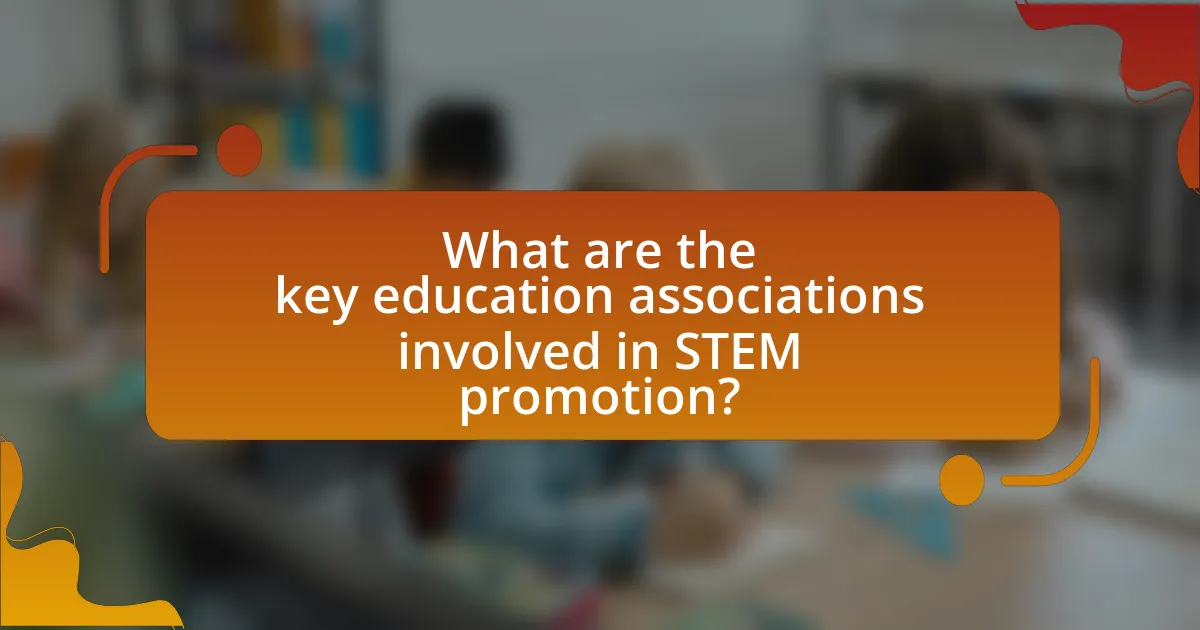
What are the key education associations involved in STEM promotion?
The key education associations involved in STEM promotion include the National Science Teachers Association (NSTA), the American Association for the Advancement of Science (AAAS), and the National Council of Teachers of Mathematics (NCTM). These organizations actively advocate for STEM education, provide resources for educators, and influence policy to enhance STEM learning opportunities. For instance, NSTA offers professional development and curriculum resources, while AAAS promotes science literacy and public engagement in science. NCTM focuses on improving mathematics education standards and practices, thereby contributing to a robust STEM education framework.
How do these associations collaborate with policymakers?
Education associations collaborate with policymakers by providing research, expertise, and advocacy to shape STEM education policies. These associations often conduct studies that highlight the importance of STEM education, presenting data and case studies to inform policymakers about effective practices and necessary funding. For instance, organizations like the National Science Teachers Association engage in direct dialogue with legislators to advocate for policies that support STEM initiatives, demonstrating the impact of such policies on student outcomes. This collaboration is essential for aligning educational standards with workforce needs, ensuring that policies reflect current educational challenges and innovations in STEM fields.
What roles do national and local education associations play?
National and local education associations play crucial roles in advocating for educational policies, providing professional development, and fostering collaboration among educators. These associations influence policy decisions at both national and local levels by representing the interests of educators and students, thereby shaping the educational landscape. For instance, the National Education Association (NEA) actively engages in lobbying for legislation that supports STEM education initiatives, ensuring that educators have access to resources and training necessary for effective teaching in these fields. Additionally, local education associations often facilitate networking opportunities and workshops that enhance teachers’ skills and knowledge, directly impacting classroom practices and student outcomes.
How do partnerships enhance STEM education initiatives?
Partnerships enhance STEM education initiatives by providing resources, expertise, and real-world applications that enrich the learning experience. Collaborations between educational institutions, industry leaders, and community organizations create opportunities for students to engage in hands-on projects, internships, and mentorship programs. For instance, a study by the National Science Foundation found that partnerships with local businesses significantly improved student engagement and understanding of STEM concepts, leading to higher achievement levels in related subjects. These partnerships also facilitate access to advanced technologies and tools, which are essential for modern STEM education.
What challenges do education associations face in promoting STEM education?
Education associations face several challenges in promoting STEM education, including limited funding, lack of qualified educators, and insufficient public awareness. Limited funding restricts the ability of these associations to develop and implement effective STEM programs, as evidenced by a report from the National Science Foundation indicating that many educational initiatives are under-resourced. The shortage of qualified educators in STEM fields further complicates efforts, with a study by the U.S. Department of Education highlighting that nearly 50% of high school STEM teachers lack a degree in their subject area. Additionally, insufficient public awareness about the importance of STEM education hampers advocacy efforts, as noted in surveys conducted by the Pew Research Center, which show that many parents and community members do not fully understand the benefits of STEM education for future job markets.
How do funding limitations affect STEM programs?
Funding limitations significantly hinder STEM programs by restricting resources necessary for effective curriculum development, teacher training, and student engagement initiatives. These financial constraints often lead to reduced access to advanced technology and laboratory equipment, which are essential for hands-on learning experiences. For instance, a report from the National Science Foundation indicates that schools with limited funding are less likely to offer advanced placement courses in STEM fields, resulting in fewer students pursuing STEM careers. Additionally, funding shortages can lead to staff layoffs or hiring freezes, diminishing the quality of instruction and mentorship available to students. Consequently, these limitations create disparities in educational opportunities, particularly in underfunded districts, ultimately affecting the overall growth and competitiveness of the STEM workforce.
What barriers exist in policy implementation for STEM education?
Barriers in policy implementation for STEM education include inadequate funding, lack of trained educators, and insufficient infrastructure. Inadequate funding limits resources for STEM programs, which affects curriculum development and access to technology. The lack of trained educators results in a shortage of qualified teachers who can effectively deliver STEM content, leading to diminished student engagement and understanding. Additionally, insufficient infrastructure, such as outdated facilities and lack of access to modern equipment, hinders the practical application of STEM concepts. These barriers collectively impede the successful implementation of policies aimed at enhancing STEM education.
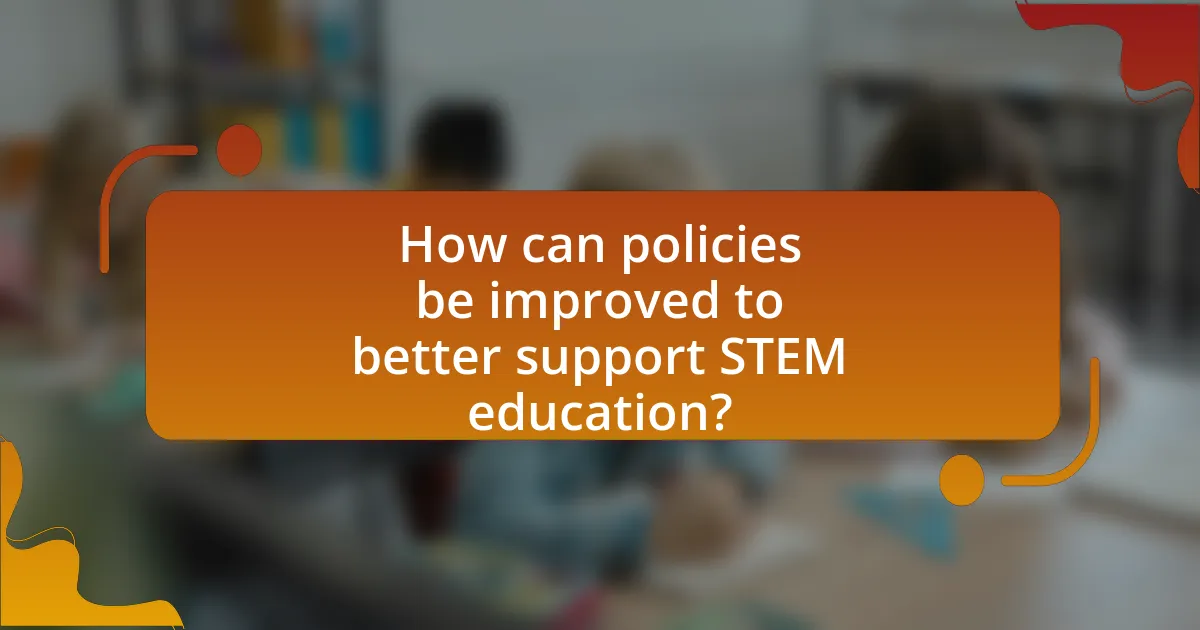
How can policies be improved to better support STEM education?
Policies can be improved to better support STEM education by increasing funding for STEM programs and enhancing teacher training initiatives. Increased funding can provide resources for updated technology, laboratory equipment, and curriculum development, which are essential for effective STEM education. For instance, the National Science Foundation reported that schools with adequate funding for STEM resources see a 20% increase in student engagement and performance in these subjects. Additionally, enhancing teacher training initiatives ensures educators are well-equipped with the latest teaching methodologies and content knowledge, which can lead to improved student outcomes. Research from the National Academies of Sciences indicates that professional development for teachers in STEM fields can significantly boost student achievement, with a reported increase of up to 30% in student test scores when teachers receive targeted training.
What best practices can be adopted by education associations?
Education associations can adopt best practices such as fostering collaboration among stakeholders, advocating for equitable access to STEM resources, and implementing evidence-based professional development programs. Collaboration among educators, policymakers, and industry leaders enhances the sharing of resources and expertise, which is crucial for effective STEM education. Advocacy for equitable access ensures that all students, regardless of background, have the opportunity to engage in STEM learning, as highlighted by the National Science Foundation’s report on diversity in STEM fields. Additionally, evidence-based professional development programs, supported by research from the Institute of Education Sciences, demonstrate improved teaching practices and student outcomes in STEM subjects.
How can data-driven approaches enhance policy effectiveness?
Data-driven approaches enhance policy effectiveness by providing empirical evidence that informs decision-making and resource allocation. By analyzing data on student performance, demographic trends, and educational outcomes, policymakers can identify gaps in STEM education and tailor interventions to address specific needs. For instance, a study by the National Science Foundation found that data-driven initiatives in education led to a 20% increase in student engagement in STEM subjects when targeted resources were allocated based on performance metrics. This evidence-based strategy ensures that policies are not only reactive but also proactive, leading to improved educational outcomes and more efficient use of funding.
What role does community engagement play in policy development?
Community engagement plays a crucial role in policy development by ensuring that the voices and needs of the community are reflected in the policies created. Engaging the community allows policymakers to gather diverse perspectives, which can lead to more effective and relevant policies. For instance, research by the National League of Cities indicates that community engagement in policy development can enhance trust in government and improve the implementation of policies, as stakeholders feel a sense of ownership and responsibility. This participatory approach not only fosters transparency but also increases the likelihood of successful outcomes by aligning policies with the actual needs and priorities of the community.
What are the future trends in STEM education policy?
Future trends in STEM education policy include increased emphasis on equity and access, integration of interdisciplinary approaches, and a focus on real-world problem-solving. Policymakers are prioritizing initiatives that ensure underrepresented groups have equal opportunities in STEM fields, as evidenced by programs aimed at increasing participation from women and minorities. Additionally, there is a growing trend towards integrating STEM with arts and humanities, fostering creativity alongside technical skills. This interdisciplinary approach is supported by research indicating that such integration enhances student engagement and learning outcomes. Furthermore, policies are increasingly promoting project-based learning and partnerships with industry to provide students with hands-on experiences that reflect current workforce needs, aligning educational outcomes with economic demands.
How might technology influence policy changes in STEM education?
Technology can significantly influence policy changes in STEM education by providing data-driven insights that inform decision-making. For instance, the integration of learning analytics and educational technology tools allows policymakers to assess student performance and engagement in real-time, leading to targeted interventions. Research from the National Science Foundation indicates that states implementing technology-enhanced learning environments saw a 20% increase in student achievement in STEM subjects. This evidence encourages policymakers to adopt and fund technology initiatives, thereby shaping educational policies that prioritize STEM education.
What emerging fields in STEM require policy attention?
Emerging fields in STEM that require policy attention include artificial intelligence, biotechnology, and renewable energy technologies. These fields are rapidly evolving and have significant implications for society, economy, and the environment. For instance, artificial intelligence is projected to contribute up to $15.7 trillion to the global economy by 2030, necessitating policies that address ethical considerations and workforce impacts. Biotechnology advancements, particularly in gene editing, raise regulatory challenges that require clear guidelines to ensure safety and ethical use. Additionally, renewable energy technologies are crucial for combating climate change, with investments in this sector needing supportive policies to promote innovation and infrastructure development.
What practical steps can education associations take to promote STEM education effectively?
Education associations can promote STEM education effectively by implementing targeted professional development programs for educators. These programs should focus on enhancing teachers’ knowledge and skills in STEM subjects, which is crucial as research indicates that teacher proficiency directly impacts student engagement and achievement in STEM fields. For instance, the National Science Foundation has reported that effective teacher training can lead to a 20% increase in student performance in mathematics and science. Additionally, education associations can foster partnerships with local industries and universities to create internship opportunities and real-world applications of STEM concepts, thereby bridging the gap between education and practical experience. By advocating for policy changes that allocate funding for STEM resources and infrastructure, education associations can further ensure that schools have the necessary tools to implement effective STEM curricula.
